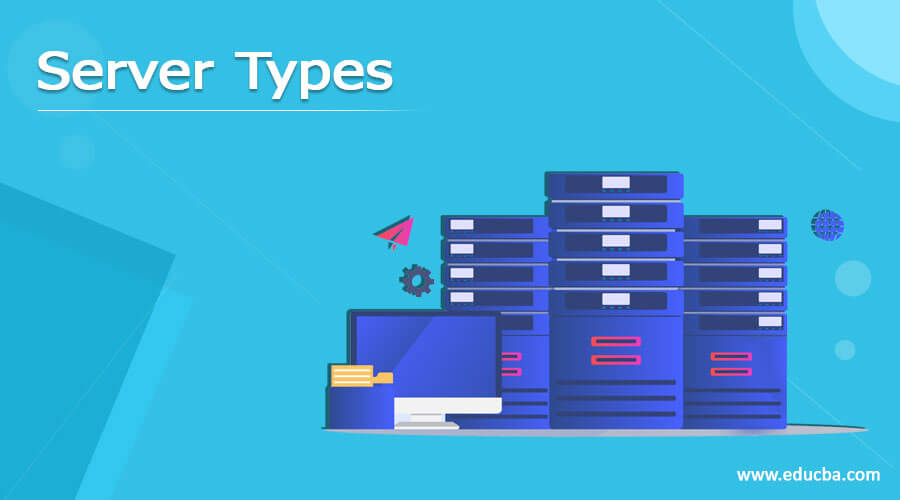Updated April 6, 2023
Introduction to Server Types
A server is a piece of computer hardware or software that provides functionality for other programs and devices. Server provides various functionalities, often called services such as sharing data or resources among multiple clients, or performing computation for client. Single server can serve multiple clients, and a single client can use multiple servers. A client process may run on the same device or may connect over a network to a server on a different device. Servers are available in various types. In This article, we are going to discuss these types.
Top 11 Types of Server
Top 11 types of server are given below:
- Application servers: Application server is a server which is used to host the application. Application server are system software upon which web application or desktop applications run. It consists of web server connector, computer programming language, database connector, runtime libraries and the Administration code. Application server frameworks are Software framework for building application server. It allows users to create both web application and server environment.
- Client servers: Client server is a distributed application that partition task or workload between the providers of resource or service called servers and service requesters are called as client Both clients and server communicate with each other over computer network on separate software hardware, but both client and server by reside in the system. Client does not share any of its resources but request resources from server
- Collaboration Servers: The goal of collaboration server is to support conduct of shared activities of software development teams. Its main concern is to support project management activities rather than project products. Collaboration server provide scheduling support for each project, team or individual. Also provides alerts for schedule reviews and collaboration event.
- Mail Servers: Mail server is server that handles and delivers email over a network, usually over the internet. It receives email from client computers and deliver them to other mail server. It also delivers email to client computers. Client computer is normal computer where user read their emails for examples computer at home or office. Also advanced mobile or smartphones with email facilities are considered client computers.
- FTP Servers: FTP server is used for transferring files supporting sub directories, log in and set of manipulation commands. It can also be used to upload HTML pages on HTTP server or download log files to remote PC. Access control interface allows users to start or stop FTP server and to manage the built-in user accounts. It uses user callback function to send the notification about FTP server to user application.
- Proxy Servers: Proxy server is a server application that acts as an intermediary for request from clients seeking resources from servers that provide those resources. Proxy server functions behalf of the client when requesting service, potentially masking the true origin of the request to the resource server. Proxy server are used as content control software, to filter the encrypted data, logging, and eavesdropping, repairing errors, accessing services, cross-domain resources, security, etc.
- Telnet Servers: Telnet server is an application protocol used to provide bidirectional interactive text orientated communication service using virtual terminal connection over internet. Telnet client application are available for virtually all computer platforms. On remote host, telnet server provides access to the command-line interface. Using TCP, user data and telnet control information is transferred on data connection.
- Real Time Communication Server: Real time communication server is also known as chat server or IRC server. It refers to instant messaging servers. Real time communication server allows large number of users to exchange the information near instantaneously. For example, call over mobile phone or landline, instant messaging like WhatsApp, Facebook, Instagram, Live tv news, video calls, etc.
- Open Source Servers: Open source server is a public domain software designed to deliver web pages over www. It runs on computers that is connected to the internet. Open source servers support file uploading and downloading using FTP, provides security features. It also supports other communication protocols.
- Web Server: Web server is a computer software and underlying hardware that Accept request through HTTP. HTTP is a network protocol which is used to distribute the web pages. Using HTTP web browser send request to the server and initiate the communication. Then web server responds with the resources or content or error message. web server also accepts and store the resources sent from the user agent.
- Virtual Servers: Virtual server is a server that is located in an offsite data center and its resources are shared by multiple users who have control over it. In other words, we can say that virtual server converts one physical server into multiple virtual machine where each can run their operating systems. Virtual servers are a more efficient use of power and can increase a server’s utilization from the typical 15 percent to as much as 80 percent. They are used for variety of applications from remote file access to web design and development.
Conclusion
Here in this article, we have discussed various types of servers such as application server, client-server, collaboration server, mail server, FTP server, Proxy server, telnet server, real-time communication server, open-source servers, web server, and virtual server. Hope you enjoyed the article.
Recommended Articles
This is a guide to ShareX Alternative. Here we also discuss the introduction and top 11 types of server along with an explanation. You may also have a look at the following articles to learn more –



